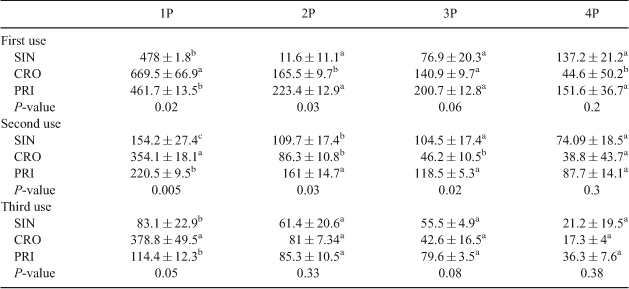10 IN VITRO PROGESTERONE RELEASE KINETICS: A COMPARATIVE STUDY OF DIFFERENT INTRAVAGINAL DEVICES USED IN CATTLE
G. C. Gomes A , A. Kehrle A , M. Maturana Filho A , C. V. F. Caetano A , J. R. V. Pimentel A , P. H. P. Miguez A and E. H. Madureira AUniversidade de São Paulo, Pirassununga, São Paulo, Brazil
Reproduction, Fertility and Development 23(1) 111-112 https://doi.org/10.1071/RDv23n1Ab10
Published: 7 December 2010
Abstract
Since progesterone releasing devices have been used for oestrous cycle control, many studies have been done to evaluate the reduce reproduction cost. However, there are few studies about reused devices. The aim of this study was to evaluate and compare in vitro P4 releasing kinetics from 3 commercially available devices: Sincrogest® (SIN, 1 g of P4), Cronipres® (CRO, 1 g of P4 and 3 rings of 0.1 g of P4 for the third use), and Primer® (PRI, 1 g of P4). For each device, new (first use, n = 2), once-used (second use, n = 2), and twice-used (third use, n = 2) devices were tested. The tests were performed in a dissolutor sink using an alcohol/water mixture (60/40, vol/vol) as a release media. Samples were collected at 0–24 h (1P), 24–48 h (2P), 48–72 h (3P), and 72–96 h (4P). Table 1 shows the P4 amount (mg) and standard deviation in the periods in which there was statistical difference (P < 0.05; a–cdifferent letters in the same period differ statistically). The 3 brands of P4 devices differ in 2 of 4, 3 of 4, and 1 of 4 intervals for 1st-, 2nd, and 3rd-use device tests respectively. Additionally, P4 release decreased according to the number of previous uses. It is known that in vitro tests are more sensible to detect differences between devices. Nevertheless, these findings suggest the possibility of targeting different device categories for different animal categories depending on the animal steroid metabolism rate and consequent need for exogenous P4. However, for such a claim, further studies on this topic are needed.

|
Supported by FAPESP – Fundação de Amparo a Pesquisa do estado de São Paulo.


